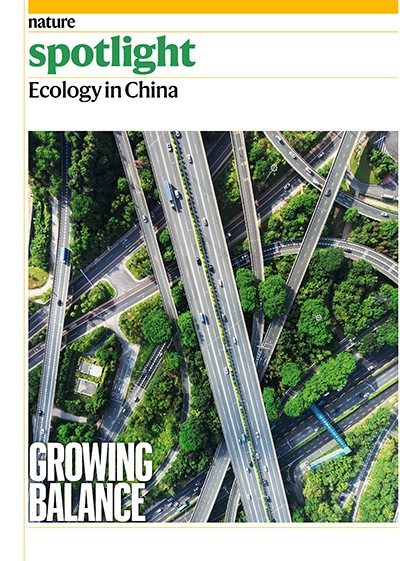
Linjun Xie is a postdoctoral researcher studying urban sustainability and environmental governance at Durham University, UK.Credit: Samer Angelone
Postdoctoral researcher Linjun Xie reveals what an eco-island on the outskirts of Shanghai taught her about sustainable development in China
What is your research area?
I study urban sustainability and environmental governance at Durham University, UK, although I’ve been home in China throughout the pandemic.
In recent decades, rural areas close to megacities such as Shanghai, Beijing and Shenzhen have been absorbed into city development plans. Chongming is one such rural area, made up of three islands in the mouth of the Yangtze River, northeast of Shanghai. The Chongming Eco-Island Project is a municipal government scheme intended to be a model for more environmentally sustainable urban development in China.
These urban transitions can alter local landscapes and ecology, causing a loss of wildlife and natural habitats, as well as environmental pollution.
So in 2010, Shanghai announced its ambition to turn the Chongming district into a modern eco-island that would balance ecological sustainability with economic growth.
How did you end up researching the impact of sustainable development in China from the United Kingdom?
After completing my degree in urban planning at Huaqiao University in Xiamen, China, I was looking for places to research sustainable development. Cardiff University in the United Kingdom offers a year-long master’s course as part of its eco-cities research programme and I joined in 2015. During my course, I heard many references to how Chongming was different from other eco-projects and so when I applied to do my PhD at the University of Nottingham Ningbo in China, I asked if I could focus on it for my thesis.
What makes Chongming different from other sustainable development projects?
Chongming is unlike other state-led eco-projects in China, such as the Tianjin eco-city, a collaborative effort between Singapore and China, or the Shenzhen International Low Carbon City. These highly compact and modern cities are constructed on empty land or previous industrial sites. In these cities, everyone is a newcomer: there are no indigenous people.
The district of Chongming, by contrast, is an environment with high-quality rural land, diverse landscapes ranging from wetlands and crop fields to forests, and it is already home to nearly 700,000 people. Their homes are spread over a large area so it feels sparsely populated. Many people have lived on the islands their whole lives. This means that you can’t start from scratch. Policies need to be integrated into the local community and ecology.
You might wonder why plans to turn a rural community into an eco-project are necessary at all. The answer is that without protections, the area will not stay this way for long. The land is close to central Shanghai and so has development value. One part of the area is not part of this eco-project and you can see how quickly high-rise buildings have gone up.
In 2010, a list of goals were set by the Chongming district government, including limits on construction, the protection of arable land and an increase in forestation.
It also set social and economic targets, such as the implementation of clean-energy transportation, consolidation of the population into compact settlements, and development of the island’s green industries, such as organic farming and low-carbon manufacturing.
How successful is this project?
Statistics show that unbridled urbanization, which is common in China, has been reversed in Chongming. For instance, by 2016 the forest coverage on Chongming was 23%, twice the average of Shanghai.
A series of ecological tourism projects have been built, such as the Dongtan Wetland Park, and tourism revenue quadrupled from 2008 to 2016, rising from 270 million yuan (US$41.7 million) to 1.09 billion yuan.
In what areas could the project be improved?
Our research revealed some concerns. For example, the targets set in the eco-island plan also serve as key evaluation criteria for officials’ job performance. So they encourage the adoption of short-term measures that are not necessarily the best long-term solutions.
For example, to increase the amount of forest cover, extensive land has been turned into forest, but plantations of a single fast-growing tree species have been introduced that do not encourage or support local biodiversity.
Seeing biodiversity from a Chinese perspective
Also, the aesthetics of the landscape are sometimes prioritized over the needs of local ecology and biodiversity: cement is often used, and uniformly landscaped riverbanks for river regulation are common. These are an attempt to improve the water quality in rivers but don’t support local wetland plants and aquatic species.
There is also the question of transport. Chongming is an attractive rural retreat for Shanghai residents and on weekends and during national holidays, the Shanghai Yangtze River Tunnel-Bridge, which directly connects the east of Chongming Island to central Shanghai, is often terribly congested.
Public transport needs to improve. Once you arrive on the island, there are electric buses and many tourists use bicycles, but cars are still more convenient when making the journey from Shanghai.
Chongming must find a balance between its economic and ecological interests. The region needs the money that comes from tourism. But to be truly sustainable it needs to become both self-reliant and environmentally secure.
In general, what needs to be done to achieve sustainable urban development?
Well-intentioned ecological initiatives can, in fact, have destructive effects if the locality is not completely understood. For example, in Chongming, government officials adopted a strategy called ‘one town, one tree species and one flower’, which meant that each local town needed to plant a different tree species and flower species in their respective jurisdiction.
The selection of plants was chosen at random from a list produced by the Chongming district government. Consequently, more than 20 species of trees were planted separately in each town, including imported varieties such as northern red oak (Quercus rubra) and red maple (Acer rubrum).
But this plan poses risks for biodiversity because new plants can destroy the natural connectivity between local species.
So it is crucial to foster connections between historians, ecologists, engineers, planners, policymakers and local communities when planning and building ecological development.


 Biodiversity’s importance is growing in China’s urban agenda
Biodiversity’s importance is growing in China’s urban agenda
 Seeing biodiversity from a Chinese perspective
Seeing biodiversity from a Chinese perspective






